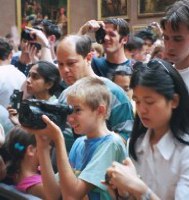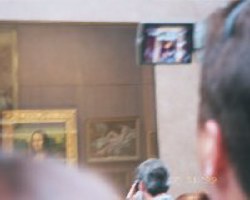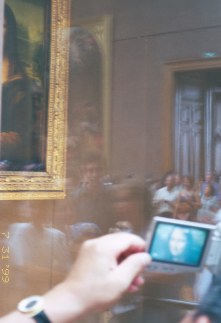Dan Bricklin's Web Site: www.bricklin.com
|
|
Our photos as an edited record of our lives
We take pictures for many reasons. Here is one very important one to understand.
|
|
With the advent of digital cameras and personal web sites, I've returned to my childhood hobby of amateur photography. Writing about different types of pictures for my Web Photo Journals web site got me thinking more about the psychological aspects of our relationship with personal photography. Pictures aren't just for the sake of being an art object -- they also have great personal meaning and are central to how we view our own lives.
This essay explores two items that gave me some insight.
Choosing photos
The first item was a few lines in a book that talked about personal photos. The book was written by Larry Kushner, a person I've known for over twenty years. He has been my Rabbi, and taught me how emotion and spirituality are an integral part of everyday life over which we have some control. In his wonderful book "Invisible Lines of Connection: Sacred Stories of the Ordinary" [Link to the book on Amazon], he writes (emphasis added):
I am in charge of the family albums in our house. I go through each roll of film and pick out the half dozen best shots...That's what history's all about: Saving photos of yourself that make you look good.
[Then one day, forced to look back at the ones he didn't pick, he commented:] Here we were like archaeologists in our own basement, looking at all the pictures of the people we had been pretending we weren't...there we were, not quite as flawless as we were in the family albums up in the living room...All this time, I had been pretending that the people in my family looked the way they did in the carefully censored photos in the album. Now I realized that these only captured one moment of millions. And that at each one of those other moments, there were other expressions, other faces, other fears and other dreams, parallel universes.
Invisible Lines of Connection, Kushner, pages 76-77
This idea of albums being an edited version of our lives as we want to remember them, not the "real thing" or just random pretty objects d'art, struck me. The techie I am, I had always looked at pictures for their artistic value, not as a personal statement of who we want to be in a life as we want to remember it. I started looking more carefully at the process of this editing.
Taking photographs is a continual process of editing. Not only do we choose the pictures we put in albums, but we also choose when to bring a camera, when to take it out, when and what to take pictures of, and when and whom to show the pictures. Through this process of choosing, we say to ourselves and others what we feel is important.
The Mona Lisa
The second item that struck me was an incident on my trip to Paris last summer. We were visiting the Louvre and went, of course, to see Leonardo da Vinci's painting of Mona Lisa. People crowded around the glass-encased painting to behold this most-famous of all portraits in person. We had all seen photos of the painting, but here we could see the real thing and contemplate why it was so special and feel the presence of the actual work of the hand of a most remarkable individual. Approaching the room, I was remembering the feeling of awe I had the year before in Florence seeing the actual telescope handmade by Galileo that he used to discover the moons of Jupiter.
 So what did people do? They took pictures. They viewed the painting in front of them through the viewfinder:
  This all got me thinking. Is there a problem with these people? Surely their pictures will be nowhere near as "good" as those they could get on any postcard or book. Also, neither they nor their loved ones are in the picture for a "Don't I look cute next to..." type of shot.
No, they were fine. What they were doing was putting together the story of their lives, and they wanted to add something famous and beautiful to it. As they tell the story of their trip they can have that important stop that they have in common with so many others. Their photo shows that they, too, experienced something great.
The fact that we instinctively take out a camera to record "famous" scenes affects our use of the camera in other settings. Bringing a camera along says that we think this will be something worth remembering. Actually taking a snapshot of something or somebody is a way of saying "At this moment, I think this is a part of my life that I want to put in my 'highlights reel'". Taking a picture of someone is a way of paying them the compliment of saying "you are important to me".
Dogs wag their tails. We take photographs.
Here's another shot I like:
 Why did I take these pictures? What was going through my head? I like telling stories. I like showing people something special they may not have noticed. Seeing all these viewfinders just struck me as something you wouldn't think about. I had in my mind the image of art students standing with intent looks or sitting and sketching. Crowds with camcorders (Video! Motion! Sound!) was not what I expected. Ira Glass of NPR wrote that surprises make good stories. This was a surprise and people to whom I showed these pictures expressed similar surprise. Voila! A story to share with you, my readers. The more I thought about it, though, I realized there is something more here. Hopefully this essay helps you (and me) understand the importance of individually choosing when to take pictures to our lives.
|
|
|
© Copyright 1999-2018 by Daniel Bricklin
All Rights Reserved.
|